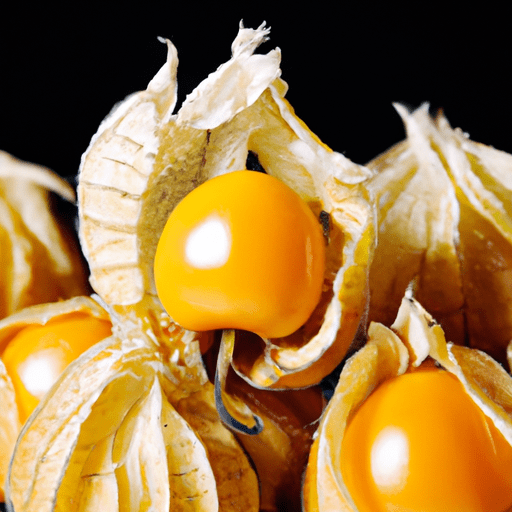The Golden Berry: A Hidden Gem in the Culinary World
Are you in search of a unique and exotic fruit to elevate your culinary creations? Look no further than the enchanting golden berry! Also known as Physalis peruviana or Cape Gooseberry, the golden berry offers a tantalizing flavor profile and a wealth of possibilities in the kitchen. In this blog post, we’ll delve into the taste, common uses, nutritional value, and fascinating history of this golden gem.
A Burst of Flavor
When it comes to taste, the golden berry does not disappoint. Enclosed within its delicate, papery husk lies a vibrant, orange berry that offers a perfect balance between sweet and tart flavors. Its initial burst of tanginess gives way to a pleasant natural sweetness, creating a delightful gustatory experience that tickles the taste buds. This unique flavor profile makes the golden berry a versatile ingredient that can be used in both sweet and savory dishes.
Culinary Applications
Chefs around the world have embraced the golden berry for its endless culinary possibilities. Here are some common uses that will inspire your kitchen adventures:
1. Fresh Delight:
Enjoy golden berries au naturel for a refreshing and healthy snack. Their bright color and tantalizing taste make them an excellent addition to fruit salads, smoothie bowls, and yogurt parfaits. The berries’ naturally low sugar content adds a subtle sweetness without overwhelming other ingredients.
2. Sweet Treats:
Golden berries shine in baked goods, lending their unique flavor to muffins, cakes, pies, and tarts. Their tartness adds depth and complexity to traditional recipes like cheesecake or fruit crumbles. Golden berry jam, compote, or coulis can also be drizzled over pancakes, waffles, or ice cream for an extra touch of indulgence.
3. Savory Pairings:
Don’t limit golden berries to sweet treats - they elevate savory dishes to new heights. Their tangy punch pairs perfectly with meats, particularly poultry or pork. Golden berries can be used in sauces, chutneys, or glazes to impart a delightful sweetness and acidity that cuts through richness. They also add a pop of color and texture to salads, salsas, or grain bowls, making every bite visually appealing.
Nutritional Powerhouse
Beyond the remarkable taste, the golden berry packs a nutritional punch. These petite fruits are a rich source of essential nutrients and offer numerous health benefits. Here are a few reasons to incorporate golden berries into your diet:
- Vitamin C Boost: Golden berries are an excellent source of vitamin C, which supports immune health and helps the body absorb iron.
- Antioxidant Rich: These berries are packed with antioxidants that help combat free radicals and reduce oxidative stress.
- Fiber Content: Golden berries are a good source of dietary fiber, promoting healthy digestion and keeping you feeling satisfied.
- Vitamin A: These berries are also a source of vitamin A, which plays a vital role in maintaining healthy vision and supporting cellular function.
A Fruit with an Intriguing Past
The golden berry’s story is as captivating as its taste. Native to South America, it has a long and rich history. Golden berries were a staple in the diet of the ancient Incas, who appreciated their unique flavor and medicinal properties. Over time, these berries made their way across the globe, captivating the palates of people worldwide. Today, they are cultivated in various regions, including South America, South Africa, and Australia, to meet the growing demand for their culinary and nutritional value.
The golden berry is truly a hidden gem in the culinary world. Its distinct taste, versatility in cooking, and impressive nutritional profile make it a must-try ingredient. Whether enjoyed fresh, incorporated into sweet treats, or used to enhance savory dishes, the golden berry adds a touch of exotic elegance to any culinary creation. So, next time you’re looking to tantalize your taste buds and impress your guests, don’t forget to reach for the golden berry - a fruit that truly shines!
Goldenberries
Origin: Goldenberries, also known as Cape gooseberries or Physalis peruviana, are native to regions of South America, including Peru, Chile, and Colombia. They have been cultivated for centuries and are now grown in various countries around the world.
Common Uses: Goldenberries have a sweet and tart flavor, which makes them versatile for both sweet and savory dishes. They are commonly used in jams, jellies, pies, tarts, and desserts. In savory preparations, goldenberries are used in salads, salsas, and chutneys. They can also be dried and eaten as a snack or used in granola bars and trail mixes.
Nutritional Benefits: Goldenberries are a great source of vitamins and minerals. They are rich in vitamin C, providing about 70% of the recommended daily intake per 100 grams. They also contain vitamin A, iron, and dietary fiber. Goldenberries are low in calories but have a good amount of carbohydrates. They are also rich in antioxidants, such as beta-carotene and polyphenols.
Unique Properties: Goldenberries have a unique husk or calyx that covers the berry. The husk is dried and papery, resembling a lantern. Inside, the small berry is yellow-orange in color, hence the name “goldenberries.” This husk acts as a protective layer and helps extend the fruit’s shelf life. Additionally, goldenberries are known for their high pectin content, making them suitable for preserving and making jams and jellies.
Historical Significance: Goldenberries have a history of culinary and medicinal use in South America. Indigenous communities utilized goldenberries for their nutritional benefits and traditional remedies. Today, their popularity has expanded beyond their place of origin, with goldenberries being cultivated and enjoyed in many countries worldwide. They are increasingly recognized for their unique flavor profile and potential health benefits.




Use the share button below if you liked it.
It makes me smile, when I see it.